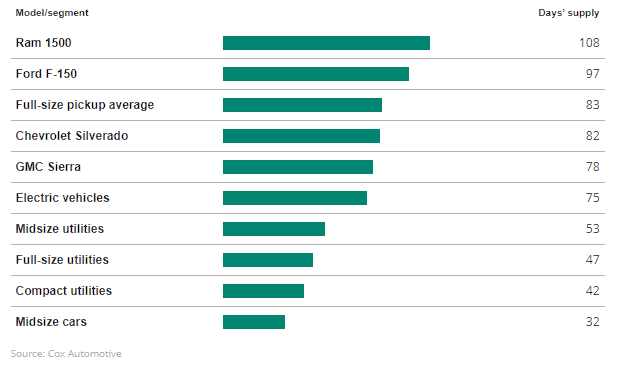Pickup Trucks Dominate Dealer Lots as Inventory Grows (PDF)
Good news for those in the market for a full-size pickup truck: inventory shortages are easing, and wait times are decreasing. This shift in availability comes just in time for the spring selling season, which means dealerships may be better equipped to meet the needs of customers. While not universal, this trend is becoming more common as inventories recover faster in the full-size pickup segment than in other vehicle segments. In fact, full-size pickups are currently the most plentiful vehicles on dealership lots, except for full-size sedans and uberluxury niche models.
Recent data suggests a significant improvement in the inventory levels of full-size pickup trucks, with supply now at 83 days compared to around 50 days the previous year. Furthermore, four out of the top five selling vehicles with the highest inventory levels are full-size pickups. Among them, the Ram 1500 has a supply of 108 days, while the F-150, Chevrolet Silverado, and GMC Sierra have 97 days, 82 days, and 78 days of inventory, respectively. General Motors has even taken steps to maintain optimal supply levels, including scheduling production downtime.

Incentives are also starting to rise, although still relatively low. Signs of a return to more normal business operations are appearing, and dealerships are starting to see the potential for turning inventory and gaining market share again.
Although GM and Ford declined to provide their own figures, they say inventory estimates are too high. GM CFO Paul Jacobson notes that demand for the company’s full-size pickups remains strong, and that April-to-date performance is trending well. Sales of the Ford F-Series rose 21% in the first quarter of 2023 from a year earlier, indicating strong demand for new vehicles.
Factors Driving Inventory Growth
According to an executive analyst at Cox Automotive, full-size pickups are experiencing a higher inventory growth rate than most other vehicle segments, and there are several reasons for this trend. One of the primary reasons is that automakers generally maintain higher inventory levels of pickups as truck customers often seek greater variety in terms of bed and cab size configurations.
Full-sized pickups are rising in popularity, but manufacturers may need to take more action to avoid an unhealthy level. Increasing incentives or putting production plants on downtime could help as GM has done. This might not be a guaranteed fix though since the UAW negotiations in autumn will have a big impact. The union is taking a tough stance and there is talk of a possible strike; the companies may then stockpile inventory, especially of the high-margin pickups.
Overall, prospective buyers of full-size pickup trucks have reason to be optimistic. Supply constraints are becoming less severe, leading to shorter wait times, and incentives are beginning to increase. As we approach the peak sales season of spring, dealerships are better equipped to accommodate the demands of consumers. Although the rising prices and interest rates may cause some concern among potential buyers, the high demand for full-size pickups remains unchanged.


